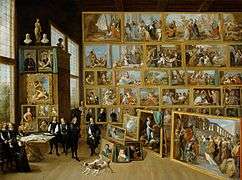Theatrum Pictorium

Theatrum Pictorium, or ‘Theatre of Painting’, is a short-hand name of a book published in the 1660s by David Teniers the Younger for his employer, the Archduke Leopold Wilhelm of Austria. It was a catalog of 243 Italian paintings in the Archduke's collection of over 1300 paintings, with engravings of the paintings taken from small models that Teniers had personally prepared. A second edition with page numbers was published in 1673.
During the years 1646-1656 Leopold Wilhelm was governor of the Netherlands and formed one of the greatest art collections of his age. Teniers effectively became its curator after the death of his predecessor Jan van den Hoecke in 1651. Leopold Wilhelm’s collection came to hold works by Hans Holbein the Elder, Pieter Bruegel the Elder, Jan van Eyck, Raphael, Giorgione, Paolo Veronese and more than 15 works by Titian. At the end of his governorship, the collection moved to the Stallburg. This archducal collection now forms the heart of Vienna’s Kunsthistorisches Museum.
Before moving to Vienna in 1659, Archduke Leopold Wilhelm formed his art collection in Brussels, where David Teniers the Younger painted views of his Brussels gallery, which are now spread among various collections:[1]
-
_-_The_Gallery_of_Archduke_Leopold_in_Brussels_-_WGA22066.jpg)
Staatsgalerie im Neuen Schloss, Schleißheim, 1640
-

Kunsthistorisches Museum, Vienna
-
.jpg)
Private collection
-

View into the picture gallery of the Archduke Leopold, by Nikolaus van Hoy in Teniers' catalog of paintings in 1673[1]
- ^ Davidis Teniers Antverpiensis, pictoris, et a cubiculis ser.mis principibus Leopoldo Guil. archiduci et Ioanni Austriaco, Theatrum pictorium : in quo exhibentur ipsius manu delineatae, eiusque curâ in aes incisae picturae, archetipae italicae, quas ipse ser.mus archidux in pinacothecam suam Bruxellis collegit, by Teniers in 1673 on archive.org
Teniers employed a team of 12 engravers for reproducing the 243 paintings in the Theatrum. He produced small copies in oil of each of the chosen paintings, issuing these as models to his engravers and 120 of which were auctioned by the estate of John Spencer-Churchill, 7th Duke of Marlborough in 1886.[2] Teniers’ painted copies measuring approximately 17 x 25 cm are now spread among various collections. The Courtauld Institute of Art Gallery holds 14 of these works, the largest group in any public collection.[3] Of the 12 engravers, the five who contributed most were Jan van Troyen with 56, Lucas Vorsterman the Younger with 52, Pieter van Lisebetten 40, Theodoor van Kessel 27, and Coryn or Quirin Boel 25.[4] Johannes Popels contributed 5 engravings.
Surviving works
The works listed in the book that survive are generally in the Kunsthistorisches Museum, while the modelli or small models for the engravings have been lost or are in other collections.
-
.jpg)
Frontispiece
-

Example of a painting by Francesco Bassano the Younger in the Kunsthistorisches Museum
-

Example of a modello by David Teniers the Younger after Bassano, also in the Kunsthistorisches Museum
-

Example of an engraving from the first, 1660, edition of the Theatrum Pictorium by Jan van Troyen after the Bassano painting
-

The Bravo (Titian) in the Kunsthistorisches Museum is also featured in the frontispiece
-

An engraving by Jan van Troyen after this painting in the Theatrum Pictorium
References
- ↑ History of the collections of the Kunsthistorisches Museum
- ↑ Fifteenth- to Eighteenth-century European Paintings in the Robert Lehman Collection: France, Central Europe, The Netherlands, Spain and Great Britain, by Metropolitan Museum of Art, Charles Sterling
- ↑ David Teniers and the Theatre of Painting, 19 October 2006 – 21 January 2007 exhibition press release on codart
- ↑ History of the project on website for Historians of Netherlandish Art
- Complete set of images from the 1660s version with associated metadata listing titles (not in the 1673 book), original artist names (note that the engravings reflect the period attributions by Teniers, while some paintings have since been reattributed), page numbers, and engravers in the Slovak National Gallery
- Copy of the 1673 book in the Getty Research Institute on archive.org
- Le Grand Cabinet Des Tableaux De L'Archi-Duc Leopold-Guillaume &c. &c. &c., record for a later version published in Amsterdam and Leipzig by Arkstée & Merkus, 1755
- Information about an exhibition about this book called David Teniers’s Theatrum Pictorium and the John G. Johnson Collection, June 12, 2010 - January 2011, at the Philadelphia Museum of Art
| Wikimedia Commons has media related to Theatrum Pictorium. |

_-_Archduke_Leopold_Wilhelm_of_Austria_in_his_Gallery_-_WGA22064.jpg)
.jpg)
